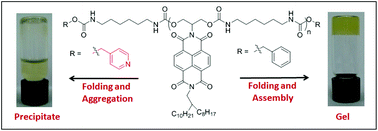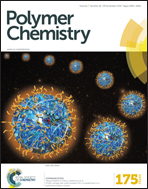A remarkable impact of a minor structural variation in the chain-end on the hierarchical self-assembly of a polymeric foldamer†
Abstract
This article elucidates a remarkable end group effect on the macroscopic assembly pathway of chain folded polyurethanes (PU) PU-2 and PU-3, both of which contain a linear PU chain appended with n-type semiconducting naphthalene-diimide (NDI) chromophores. They only differ in the structure of the chain-stoppers (pyridine and benzene, respectively, for PU-2 and PU-3), which were installed during the poly-condensation reaction by the addition of a suitable mono-functional impurity. In methylcyclohexane (MCH), both polymers adopt a pleated structure by intra-chain H-bonding between the urethane groups, which assists the pendant NDI chromophores to organize in close proximity for aromatic interaction. For PU-3 with benzene end groups, the individual pleated structures coalesce through inter-chain H-bonding among the terminal urethane groups leading to the formation of a polymersome like structure, which upon aging causes nanotubular assembly and macroscopic gelation. On the other hand, just by replacing the terminal benzene functionality with pyridine, it is possible to fully block this self-assembly pathway as the chain stopper forms a knot at the terminal by intra-chain H-bonding with the adjacent urethane proton. Therefore, PU-2 though initially forms a pleated structure, similar to PU-3, with aging forms micron size particles and irregular aggregates leading to precipitation. Now interestingly, the programmed self-assembly pathway towards the nanotubular structure can be restored in the presence of an external structure directing agent (ESDA). Because the carboxylic acid group of the ESDA, being a stronger H-bond donor than the urethane proton, forms a H-bonded complex with the nitrogen atom of the pyridine group, the knot formation is prohibited. In the presence of a chiral ESDA that forms a H-bonded complex with the terminal pyridine, chirality can be induced to the folded polymer assembly which is evident by the observed bisignated CD curve centered at the absorption maxima of the polymer-appended NDI chromophore though the NDI appended polymer chain lacks any chiral center. At elevated temperatures even when the H-bonding is broken between the chiral ESDA and the polymer chain, the chirality survives for about an hour illustrating a short term chiral memory effect.


 Please wait while we load your content...
Please wait while we load your content...